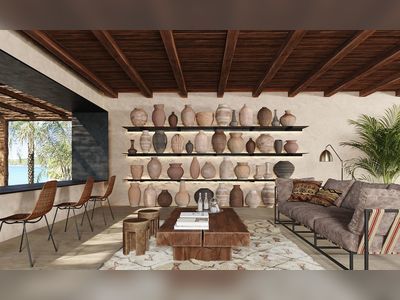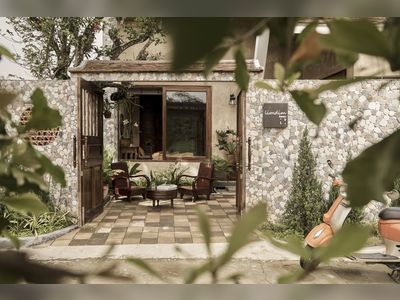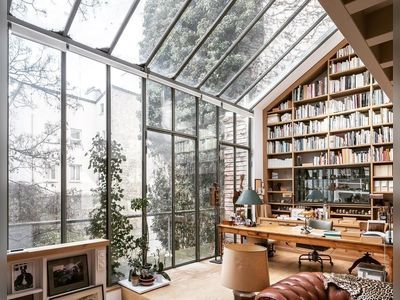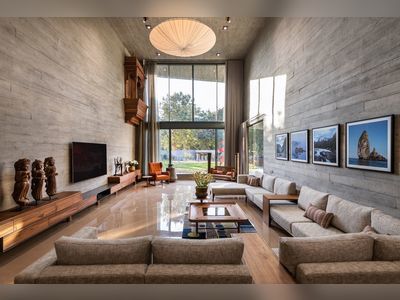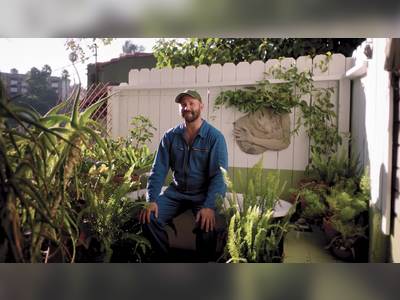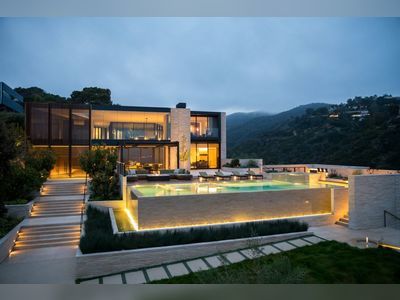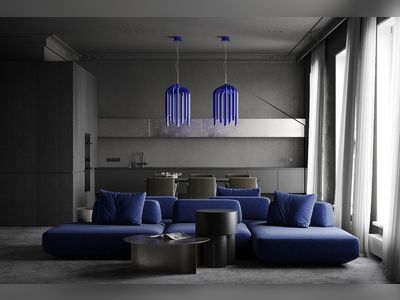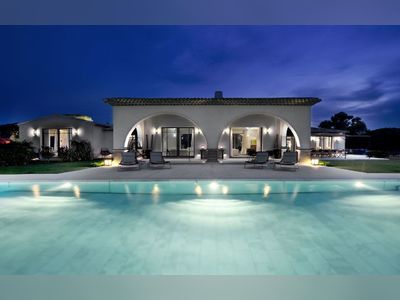"You really do not know if the results will be what you want until the tiles are fired. Only experience teaches the techniques."
Each of the four Hawaii-based tile artists profiled here would agree with this comment by Sandy Sater. All four echo her opinion that the chameleon nature of glazes under fire is vitally important to master when working with tile. And these four are indeed masters of an art form that gives a Hawaiian emphasis to kitchens and bathrooms with rich depictions of Island geography, wildlife and vegetation.
Of course, their success requires much more than a knack for the alchemy of glaze and kiln. Each of these artists has also perfected a personal Hawaiian style and developed an oeuvre of distinctive tile art that can transport a kitchen or bathroom to the tropics -- and beyond.
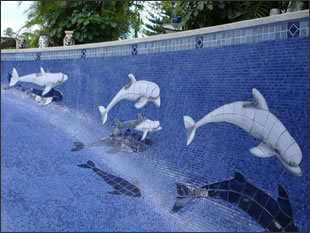
Robert Vogland's realistic style of tile art has frequently been described as magical in its ability to fool the eye. Due to his virtuosic use of perspective and depth, his tile dolphins and sea turtles seem to float on the water and cast shadows on the pool floor, even spooking the occasional swimmer. Having just completed an epic 26-foot long mural of the iconic hands in Michelangelo's "The Creation of Adam" for a pool in Egypt, Vogland's work now spans the globe. But when he makes a foray from pool to shower, he encounters an unfamiliar quandary.
If the occasional curved installation surface poses unique difficulties for the tile artist in a pool, at least the extent of the canvas is vast. The expanse of a pool can accommodate a variety of artistic tile subjects -- and their change in size when fired -- in a sea of plain blue tile. But the successful installation of Vogland's shower murals depends greatly on his ability to fire a jigsaw of raw clay pieces to a precise size.
"A change in size might throw off the entire design," he says. Because the amount of shrinkage varies greatly in proportion to the wetness of the clay, Vogland must carefully monitor the moisture of his clay, which allows him to better control for size. And size isn’t the only variant; there’s also the unpredictability of the final color after firing.
If the occasional curved installation surface poses unique difficulties for the tile artist in a pool, at least the extent of the canvas is vast. The expanse of a pool can accommodate a variety of artistic tile subjects -- and their change in size when fired -- in a sea of plain blue tile. But the successful installation of Vogland's shower murals depends greatly on his ability to fire a jigsaw of raw clay pieces to a precise size.
"A change in size might throw off the entire design," he says. Because the amount of shrinkage varies greatly in proportion to the wetness of the clay, Vogland must carefully monitor the moisture of his clay, which allows him to better control for size. And size isn’t the only variant; there’s also the unpredictability of the final color after firing.
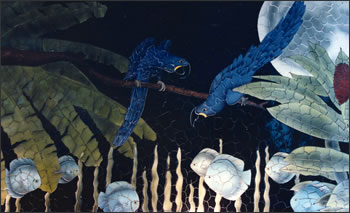
"Every application of glaze that I make takes two days for me to see the results,” he says. “I feel as though I am decorating blindfolded for two days." Guessing game though it may seem, the striking depth and variety of colors Vogland achieves in a single firing are the rewards of studied practice. He manually spins his glaze in its jar, listening for the telltale indications of relative viscosity "that have taken years for me to understand. Just by the sound of the viscosity of the glaze -- and how it was applied -- I can understand the strengths" of its color, he explains.
While applying glaze, Vogland introduces a new complexity. "I layer many different colors," he says. "Ceramic colors do not mix like oils. When they mix, they combine many different elements that melt together. Sometimes when they melt, the combined colors come up with a whole brand-new color that you were not expecting."
Vogland admits that he takes occasional notes, but mostly relies on skills learned as an apprentice or developed over 23 years of tile work. His calling began with his first ceramics class at the University of Puget Sound, where he earned a bachelor’s in fine arts and international business.
Since that first class, the appeal of tile for Vogland -- and the reason it is the ideal artistic medium for the pools, showers, and bathrooms he adorns -- has been the staying power of fired ceramics. "The advantage of working with tile is its strength, allowing for permanent installations," he says.
But if it would stand permanently, a shower mural should be imbued with a permanent beauty as well. "Immortal images ought to be beautiful," says the ambitious Vogland, who cites Antoni Gaudi as someone he would like to impress with his work. He brings a detailed delicacy to the vibrant color and elegant form of the red ginger, heliconia, Hong Kong orchids, and other exotic flowers that decorate his bathroom murals, some of which evoke another artist who sojourned in Hawaii. "Georgia O'Keefe is a great influence… How she visited here and created,” he says.
Vogland, who moved to Hawaii from the Pacific Northwest in 1984, estimates that he's created nearly 2,000 commissions, encompassing over a million tiles, all made in his Kailua studio on Oahu's verdant windward side.
While applying glaze, Vogland introduces a new complexity. "I layer many different colors," he says. "Ceramic colors do not mix like oils. When they mix, they combine many different elements that melt together. Sometimes when they melt, the combined colors come up with a whole brand-new color that you were not expecting."
Vogland admits that he takes occasional notes, but mostly relies on skills learned as an apprentice or developed over 23 years of tile work. His calling began with his first ceramics class at the University of Puget Sound, where he earned a bachelor’s in fine arts and international business.
Since that first class, the appeal of tile for Vogland -- and the reason it is the ideal artistic medium for the pools, showers, and bathrooms he adorns -- has been the staying power of fired ceramics. "The advantage of working with tile is its strength, allowing for permanent installations," he says.
But if it would stand permanently, a shower mural should be imbued with a permanent beauty as well. "Immortal images ought to be beautiful," says the ambitious Vogland, who cites Antoni Gaudi as someone he would like to impress with his work. He brings a detailed delicacy to the vibrant color and elegant form of the red ginger, heliconia, Hong Kong orchids, and other exotic flowers that decorate his bathroom murals, some of which evoke another artist who sojourned in Hawaii. "Georgia O'Keefe is a great influence… How she visited here and created,” he says.
Vogland, who moved to Hawaii from the Pacific Northwest in 1984, estimates that he's created nearly 2,000 commissions, encompassing over a million tiles, all made in his Kailua studio on Oahu's verdant windward side.
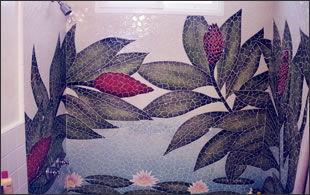
Sandra Sater has been a professional ceramic artist for 33 years, 29 of them on the Big Island. Located on the slopes of Hualalai volcano, her studio and factory outlet store, Kani of Hawaii, is named in reference to her persona in Hawaii (“Kani” is Hawaiian for Sandy). The studio’s name may also reflect the Island transformation that her ceramics background has undergone here.
"My artistic influences are just my own vision, and nature," she explains. Schooled in Los Angeles at the Chounaird Art School (now Cal Arts), Sater was mesmerized by a camping trip across Hawaii in 1978. She found herself moving soon thereafter to the Big Island, where she would raise her two children and build a bustling ceramics business. "When your art is your living, it's a nice job. I love living in Kona and I love the ocean," she says. "I paddle canoe."
In addition to the influence of her tropical environment, there's a practical reason why Sater's natural surroundings made their way into her work. "I do the themes that the clients want for their homes,” she says. “My work is always in a Hawaiian, floral, or ocean motif.”
Slater has worked with tile on and off, but heavily for the past five years.. Most of her tile commissions originate when showroom visitors view tile samples bursting with plumeria blossoms, seashells and palm fronds that almost leap off of the walls. Their three-dimensional textures are born of hand craftsmanship.
"My artistic influences are just my own vision, and nature," she explains. Schooled in Los Angeles at the Chounaird Art School (now Cal Arts), Sater was mesmerized by a camping trip across Hawaii in 1978. She found herself moving soon thereafter to the Big Island, where she would raise her two children and build a bustling ceramics business. "When your art is your living, it's a nice job. I love living in Kona and I love the ocean," she says. "I paddle canoe."
In addition to the influence of her tropical environment, there's a practical reason why Sater's natural surroundings made their way into her work. "I do the themes that the clients want for their homes,” she says. “My work is always in a Hawaiian, floral, or ocean motif.”
Slater has worked with tile on and off, but heavily for the past five years.. Most of her tile commissions originate when showroom visitors view tile samples bursting with plumeria blossoms, seashells and palm fronds that almost leap off of the walls. Their three-dimensional textures are born of hand craftsmanship.
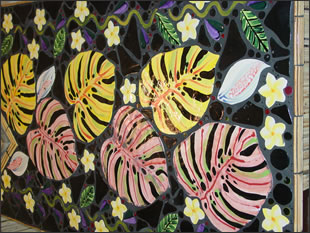
"I make the tile myself,” says Slater. “ I lay it out on a big eight-by-eight-foot table and, after calculating shrinkage, cut out the requested image by hand. Of course pre-manufactured tile does not shrink, so it is easier to fit and much flatter. My look is much more flowing, with grout lines running along the natural contours of the plants and animals."
After she cuts the clay according to design, the process of adding layers of glaze begins. "Think of it as a club sandwich," Sater advises. "Clay first, then underglazes (color) -- sometimes airbrushed on and sometimes hand-painted -- and then clear glaze." Fired to 2100 degrees Farenheit, the tiles show their true colors and demonstrate, sometimes painfully, the artist's experience with glaze application. "The colors are very reliable," Sater says. "It is the application that is critical."
The handmade, imperfect-by-design nature of Sater's ceramics combine with her personal artistic touch for a style that emphasizes a sense of joy over strict realism. Her tile mosaic turtles have an inviting air that approaches animation, while her woven mat or bamboo accent tiles are not quite perfect squares.
With characteristic Aloha, Sater aims to make her work as "affordable as possible, so that it is easy to purchase and fun to give." She explains that for a bathroom or kitchen, it is attractive to incorporate elements of art tile into the field of plain tiles. "This is an economical way to bring color, interest and uniqueness to a room,” she says.
Slater’s work can be found in a number of fine shops, including Martin & McArthur, as well as in her factory outlet store in Kailua-Kona, which also features pottery, paintings and new, vintage and Hawaiiana clothing and jewelry.
After she cuts the clay according to design, the process of adding layers of glaze begins. "Think of it as a club sandwich," Sater advises. "Clay first, then underglazes (color) -- sometimes airbrushed on and sometimes hand-painted -- and then clear glaze." Fired to 2100 degrees Farenheit, the tiles show their true colors and demonstrate, sometimes painfully, the artist's experience with glaze application. "The colors are very reliable," Sater says. "It is the application that is critical."
The handmade, imperfect-by-design nature of Sater's ceramics combine with her personal artistic touch for a style that emphasizes a sense of joy over strict realism. Her tile mosaic turtles have an inviting air that approaches animation, while her woven mat or bamboo accent tiles are not quite perfect squares.
With characteristic Aloha, Sater aims to make her work as "affordable as possible, so that it is easy to purchase and fun to give." She explains that for a bathroom or kitchen, it is attractive to incorporate elements of art tile into the field of plain tiles. "This is an economical way to bring color, interest and uniqueness to a room,” she says.
Slater’s work can be found in a number of fine shops, including Martin & McArthur, as well as in her factory outlet store in Kailua-Kona, which also features pottery, paintings and new, vintage and Hawaiiana clothing and jewelry.

Loreen Matsushima has been painting professionally since she was 15, but that didn't stop the Hawaii-born artist from pursuing bachelor's and master's degrees in fine arts from the University of Hawaii and the Pratt Institute in New York, respectively. She first turned to painting on ceramic media three years ago, yet a career's worth of painting acumen goes into every brushstroke on her art tilework.
"Painting on tile is really no different from painting on canvas,” says Matsushima. “ The same fundamental principles apply in the application of paint whether you are painting on paper, canvas or tile. However, the glazed tile surface is easily maintained,” she says, “whereas a painting on canvas is more susceptible to damage caused by mold, mildew, bugs, etc."
And of course there's the perennial problem of the changes in the hue of the ceramic glazes in the kiln. Like an artist painting over her work, Matsushima takes a painterly perspective on this drawback of tile: "The ceramic medium is forgiving, so it is easily re-glazed and fired again."
Matsushima creates two lines of tile design that are particularly Hawaiian in style: Fish on Tile and Tropica (she also has a line of contemporary, abstract design tiles). "They reflect the flora and fauna of our environment," she comments. Her Fish on Tile also reflect Hawaii's cultural debt to Japan and Asia, where the style she adopts first originated. "I employ the ancient Japanese method of Gyotaku, or fish print, to the tile,” she explains.
An artform initially used by fishermen in the 1800s, Gyotaku (from gyo, "fish" and taku, "rubbing") is the imprint on rice paper of a fish painted with sumi ink or other painting material, providing an exact account of one's catch. "But unlike rice paper, the tile medium is less absorbent, so the impression of the fish is very slight and must be painted,” Matsushima says. Nonetheless, her schools of fish are true to life. The resulting tile artworks make especially striking additions to an interior when painted on a plain, white tile background.
Matsushima's western artistic influences are more apparent in herTropica line (post-impressionist fruits, flowers and ferns on tile). "Cezanne had the greatest impact and was most influential in how I perceive the world from the perspective of an artist in which color, shapes, and space work together harmoniously," she says. Her delicately blurred plumeria loom brightly, appearing as dreamlike forms in contrast to their cooler, watery background.
"Painting on tile is really no different from painting on canvas,” says Matsushima. “ The same fundamental principles apply in the application of paint whether you are painting on paper, canvas or tile. However, the glazed tile surface is easily maintained,” she says, “whereas a painting on canvas is more susceptible to damage caused by mold, mildew, bugs, etc."
And of course there's the perennial problem of the changes in the hue of the ceramic glazes in the kiln. Like an artist painting over her work, Matsushima takes a painterly perspective on this drawback of tile: "The ceramic medium is forgiving, so it is easily re-glazed and fired again."
Matsushima creates two lines of tile design that are particularly Hawaiian in style: Fish on Tile and Tropica (she also has a line of contemporary, abstract design tiles). "They reflect the flora and fauna of our environment," she comments. Her Fish on Tile also reflect Hawaii's cultural debt to Japan and Asia, where the style she adopts first originated. "I employ the ancient Japanese method of Gyotaku, or fish print, to the tile,” she explains.
An artform initially used by fishermen in the 1800s, Gyotaku (from gyo, "fish" and taku, "rubbing") is the imprint on rice paper of a fish painted with sumi ink or other painting material, providing an exact account of one's catch. "But unlike rice paper, the tile medium is less absorbent, so the impression of the fish is very slight and must be painted,” Matsushima says. Nonetheless, her schools of fish are true to life. The resulting tile artworks make especially striking additions to an interior when painted on a plain, white tile background.
Matsushima's western artistic influences are more apparent in herTropica line (post-impressionist fruits, flowers and ferns on tile). "Cezanne had the greatest impact and was most influential in how I perceive the world from the perspective of an artist in which color, shapes, and space work together harmoniously," she says. Her delicately blurred plumeria loom brightly, appearing as dreamlike forms in contrast to their cooler, watery background.
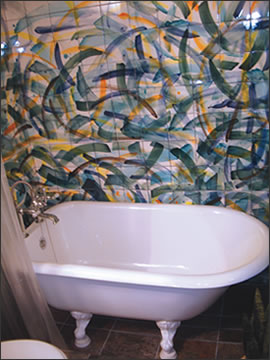
When it comes to finding the right design for a kitchen or bathroom, Matsushima always keeps an eye on accentuating what's already there. "I work collaboratively with my clients, many of whom have interiors that incorporate natural elements, so the tile design is tailored to complement the space in which it will exist,” she says.
Though her previously designed works may be purchased directly from her website, Matsushima is open to developing ideas and exploring design possibilities with clients at her Honolulu studio and showroom. She explains: "While the tile sizes are standard, ranging from four square inches to 12 square inches, there is no limitation in terms of design or total dimension of the finished piece. The design can be borders, accent pieces, or an entire mural."
Though her previously designed works may be purchased directly from her website, Matsushima is open to developing ideas and exploring design possibilities with clients at her Honolulu studio and showroom. She explains: "While the tile sizes are standard, ranging from four square inches to 12 square inches, there is no limitation in terms of design or total dimension of the finished piece. The design can be borders, accent pieces, or an entire mural."
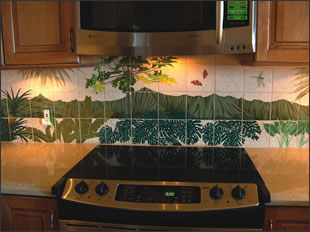
Thomas Deir's tile murals are familiar to anyone who visits Oahu even a few times. They adorn the Hilton Hawaiian Village in Waikiki, Turtle Bay Hotel on the North Shore of Oahu, Hanauma Bay Nature Preserve and Sea Life Park near Makapuu, Oahu.
Deir started working with tile when he was freelancing as a graphic artist and landed a commission to do four murals. He mastered ceramics, but he did not consider himself a painter on the level of artists he admired. "It was overwhelming for me to think that I could paint like that," says Deir. Then he apprenticed with John Pitre, a modernist known for his detailed fantasy work. In collaboration with Pitre, Deir co-invented a groundbreaking paint for artists that proved popular around the world.
Deir now prides himself on the being "an artist who can do anything on tile for your home, from tropical fronds surrounding your shower, to bamboo on your kitchen backsplash, to a complete ocean in your shower with turtles, fishes and light rays." Over the years, he has witnessed a change in the demand for particular Hawaiian geographies and color palettes in the murals he's commissioned to paint. "Although the trend 10 years ago was underwater reef scenes, there has been a shift from the blues and sea greens (cool colors) to the beiges and mountain greens (warm colors)," says Deir. "I call it the 'Tommy Bahamas' effect."
Deir started working with tile when he was freelancing as a graphic artist and landed a commission to do four murals. He mastered ceramics, but he did not consider himself a painter on the level of artists he admired. "It was overwhelming for me to think that I could paint like that," says Deir. Then he apprenticed with John Pitre, a modernist known for his detailed fantasy work. In collaboration with Pitre, Deir co-invented a groundbreaking paint for artists that proved popular around the world.
Deir now prides himself on the being "an artist who can do anything on tile for your home, from tropical fronds surrounding your shower, to bamboo on your kitchen backsplash, to a complete ocean in your shower with turtles, fishes and light rays." Over the years, he has witnessed a change in the demand for particular Hawaiian geographies and color palettes in the murals he's commissioned to paint. "Although the trend 10 years ago was underwater reef scenes, there has been a shift from the blues and sea greens (cool colors) to the beiges and mountain greens (warm colors)," says Deir. "I call it the 'Tommy Bahamas' effect."
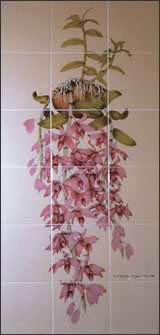
Like other tile artists, he gets plenty of work depicting native flora. "There's definitely a preference,” he observes, “for local plants and flowers: lawai ferns; anthurium flowers and leaves; plumeria flowers and leaves; hibiscus flowers and leaves; banana leaves; pineapple fruit and leaves; monsterra leaves; bird of paradise flowers and leaves; and coconut trees and palm fronds."
Whether it's a busy jungle scene or spare and soothing accents he is portraying, Deir paints directly on pre-manufactured tile, of which he has tested and approved a few select varieties. "However, if there is a particular type of tile the client wants, I just need to test-fire it," he adds.
To re-create the rainbow of colors found in Hawaii's outdoors, Deir has fired murals as many as six times. "It's all about control," he says. "I have 20 years of experience and I do extensive glaze formulations and tests. I can and do re-fire layers of detail, shadows, clear glazes, and filled color(s)" for added depth and richness. "Color is a science,” he adds. “Understanding this science is a must for an artist to execute a desired result successfully."
After he makes the necessary color underglaze application, Deir's murals get a specific glaze finish depending on their subject matter. "Glaze is like a varnish on a painting," he suggests. "For my reef scenes I desire a very shiny surface, so I paint the mural with underglazes and finish fire it with a coat of clear glaze. For the kitchen tropical fronds and flowers and bamboo murals, the desired surface is a matte finish, so I just brush on the glaze and underglaze and fire it, leaving a semi-glossy or glossy brushstroke on a matte tile."
A final, unseen attribute of Deir's work is the impact made by his beloved Island surroundings, which he refuses to take for granted. "The abundance of beauty in Hawaii and the spirit of Aloha definitely influence one’s attitude towards the positive, because of the gratitude we have for living here,” he says.
This deep appreciation of Hawaii’s special “sense of place” is something that Deir shares with his fellow tile artists. Both individually and as a group, they have allowed this tropical inspiration to lead them to develop and explore their own personal Hawaiian styles.
Whether it's a busy jungle scene or spare and soothing accents he is portraying, Deir paints directly on pre-manufactured tile, of which he has tested and approved a few select varieties. "However, if there is a particular type of tile the client wants, I just need to test-fire it," he adds.
To re-create the rainbow of colors found in Hawaii's outdoors, Deir has fired murals as many as six times. "It's all about control," he says. "I have 20 years of experience and I do extensive glaze formulations and tests. I can and do re-fire layers of detail, shadows, clear glazes, and filled color(s)" for added depth and richness. "Color is a science,” he adds. “Understanding this science is a must for an artist to execute a desired result successfully."
After he makes the necessary color underglaze application, Deir's murals get a specific glaze finish depending on their subject matter. "Glaze is like a varnish on a painting," he suggests. "For my reef scenes I desire a very shiny surface, so I paint the mural with underglazes and finish fire it with a coat of clear glaze. For the kitchen tropical fronds and flowers and bamboo murals, the desired surface is a matte finish, so I just brush on the glaze and underglaze and fire it, leaving a semi-glossy or glossy brushstroke on a matte tile."
A final, unseen attribute of Deir's work is the impact made by his beloved Island surroundings, which he refuses to take for granted. "The abundance of beauty in Hawaii and the spirit of Aloha definitely influence one’s attitude towards the positive, because of the gratitude we have for living here,” he says.
This deep appreciation of Hawaii’s special “sense of place” is something that Deir shares with his fellow tile artists. Both individually and as a group, they have allowed this tropical inspiration to lead them to develop and explore their own personal Hawaiian styles.
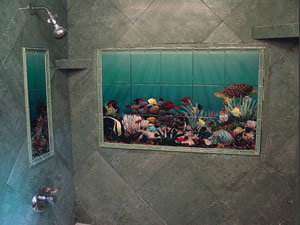
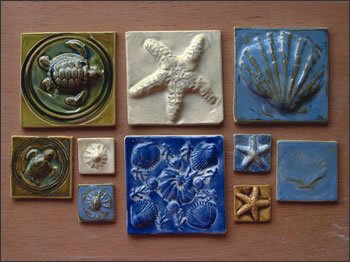
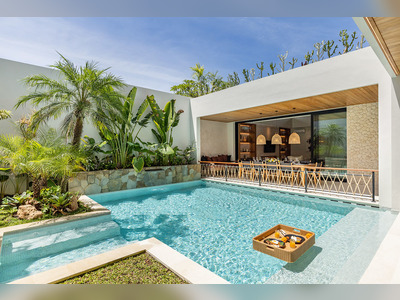
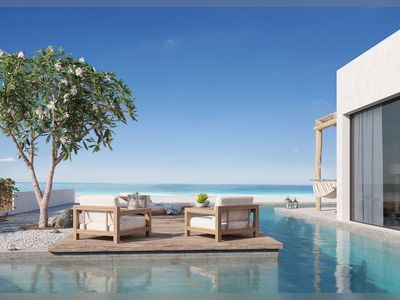
![A Tranquil Jungle House That Incorporates Japanese Ethos [Video]](/images/22/08/b-2ennetkmmnn_t.jpg)
